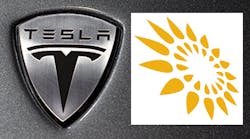Shareholders of both Tesla Motors Inc. and SolarCity Corp. should vote in favor of the proposed $2.3 billion deal that would merge the companies, at least according to advisory firm Institutional Shareholder Services.
With a market value of about $30 billion, Tesla would be able to bridge the funding gap with cash-burning SolarCity, and the deal is a necessary step in the electric-car maker’s push to become an integrated sustainable energy company, ISS said in a report Friday. The firm also said Tesla gave minority shareholders enough of a voice to overcome governance concerns. Both companies have scheduled votes on Nov. 17.
The proposal to merge the two companies has been controversial since it was announced in June and Tesla shares fell 10% that day as some stockholders worried that the solar-panel installer’s debt and cash situation would be a burden on the carmaker. There were also corporate governance concerns because Tesla CEO Elon Musk owns more than 20% of both companies and his cousin, Lyndon Rive, is CEO of SolarCity.
The ISS report said that, while Tesla has a “suboptimal governance structure,” the requirement that a majority of unrelated shareholders be required to approve the deal helps get past that issue.
ISS also said that Tesla “is paying a low to no premium to take over SolarCity.” The announced cost synergies of $150 million, even if capitalized at a low multiple of 10 times, would create $1.5 billion, the equivalent of almost two-thirds of the acquisition price, according to the firm.
For SolarCity shareholders, the offer represents a 14% premium over the stock price on June 21, the last trading day before the proposal was announced, ISS said. It also gives those shareholders Tesla stock, which is easier to trade, the firm said.
Musk is the chairman and CEO of Tesla and the chairman, as well as chairman and the largest financier of SolarCity. Since the deal was announced, Musk has stressed the clean-energy synergies between the two companies, noting at a Los Angeles event to tout a new solar roof product that solar and battery storage go together like “peanut butter and jelly.”
Some shareholders have raised concerns about overlapping boards and corporate governance issues, while others worry that integrating SolarCity will be a distraction from Tesla’s plans to bring the Model 3 car to market next year and ramp up output at both its auto factory in Fremont, California, and Gigafactory battery plant near Reno, Nevada.
Musk sought to allay many concerns in a presentation to analysts Nov. 1, saying that SolarCity will add $1 billion in revenue to the combined company in 2017 and $500 million in cash to Tesla’s balance sheet over the next three years. He also said that “quite a few naysayers from big hedge funds” have been wrong about Tesla in the past with a “batting average of zero.”
Other proxy advisers such as Glass Lewis & Co. and Egan-Jones Ratings Co. are expected to issue recommendations on the merger proposal. The opinions aim to influence the vote of fund managers and other shareholders in the deal.
By David Welch and Dana Hull




